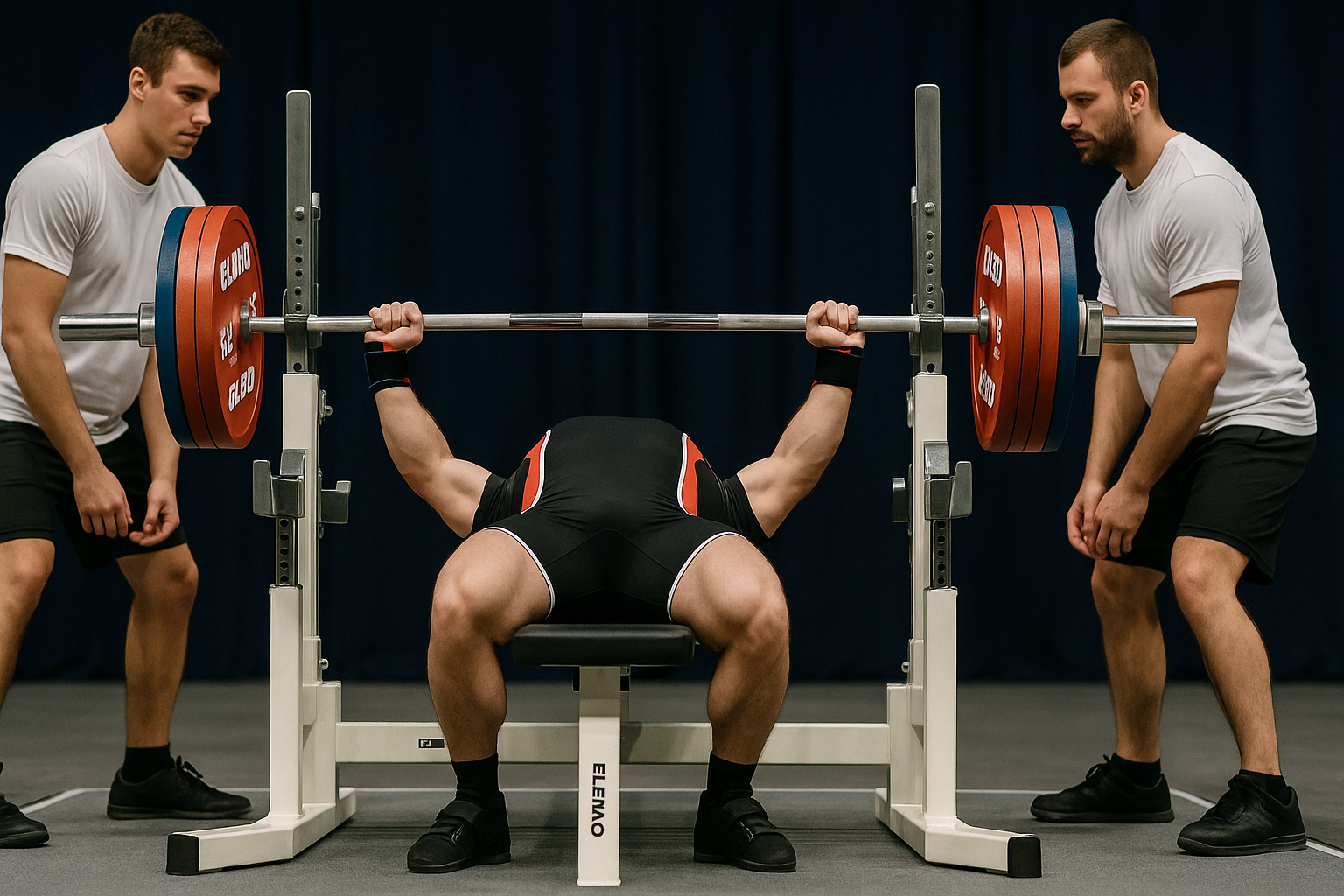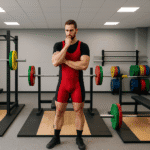Master the powerlifting bench press with proper form, competition standards, and advanced techniques to maximize your strength and performance.
The bench press stands as one of the three core lifts in powerlifting, alongside the squat and deadlift. Unlike recreational bench pressing, powerlifting bench press demands precise technique, adherence to competition standards, and strategic programming to achieve maximum single-rep strength. This comprehensive guide covers everything from basic setup to advanced competition strategies.
Understanding Powerlifting Bench Press vs. Bodybuilding Bench Press
Powerlifting bench press prioritizes moving maximum weight for a single repetition under competition rules, while bodybuilding bench press focuses on muscle development through higher repetitions. Key differences include:
- Range of Motion: Powerlifting requires touching the chest and pausing, while bodybuilding may use partial reps
- Arch Positioning: Powerlifting allows and encourages back arch within legal limits
- Equipment: Powerlifting permits specialized gear like bench shirts in equipped divisions
- Tempo: Powerlifting emphasizes controlled eccentric and explosive concentric phases
Competition Rules and Standards
Understanding competition standards ensures your training translates to meet success. The International Powerlifting Federation (IPF) and other federations require:
The Three Commands
- “Start” – Begin the lift after unracking
- “Press” – Given after the bar touches chest and becomes motionless
- “Rack” – Complete the lift after full arm extension
Legal Requirements
- Bar must touch the chest or abdominal area
- Definite pause at the chest until “Press” command
- Even upward movement to full arm extension
- Feet must remain flat on floor throughout lift
- Head, shoulders, and buttocks must maintain bench contact
Optimal Setup and Positioning
Foot Placement
Position feet firmly on the floor, slightly wider than hip-width apart. Advanced lifters may use a narrower stance to increase arch, but feet must remain flat per competition rules. Foot placement affects your ability to generate leg drive and maintain stability throughout the lift.
Back Arch Technique
The powerlifting arch serves multiple purposes: reduces range of motion, engages the stronger upper chest fibers, and creates a stable base. To achieve proper arch:
- Lie on the bench and pull shoulder blades together
- Drive feet into the floor while lifting hips slightly
- Settle hips back down while maintaining arch
- Keep shoulder blades pinched throughout the lift

Grip Width and Hand Position
Grip width significantly impacts muscle recruitment and mechanical advantage. Most powerlifters use a grip 1.5-2 times shoulder width, placing hands near the grip rings on a standard powerlifting bar. Consider these factors:
- Wider Grip: Reduces range of motion, emphasizes chest and front deltoids
- Closer Grip: Increases tricep involvement, may allow for better shoulder health
- Hand Position: Maintain straight wrists with bar resting in the palm, not fingers
Proper Lifting Technique
The Descent (Eccentric Phase)
Control the bar’s descent to touch the chest at approximately nipple level or slightly below. The descent should take 2-3 seconds, allowing you to maintain control while conserving energy for the press. Key points:
- Maintain tight upper back and core
- Keep elbows at approximately 45-degree angle to torso
- Breathe during descent or hold breath for stability
- Touch the chest gently but definitively

The Pause
Competition requires a definite pause at the chest until receiving the “Press” command. During training, practice pausing for 1-2 seconds to develop this skill. The pause should maintain muscle tension while the bar remains motionless on the chest.
The Press (Concentric Phase)
Drive the bar up forcefully while maintaining proper form. Focus on:
- Pressing the bar slightly back toward the rack
- Engaging lats to maintain stability
- Using leg drive to assist the press
- Maintaining wrist and elbow alignment
Breathing and Bracing Techniques
Proper breathing enhances stability and power output. Two primary approaches work effectively:
Method 1: Breath and Hold
Take a deep breath at the top, hold throughout the entire rep, then exhale after racking. This method maximizes intra-abdominal pressure and stability.
Method 2: Tactical Breathing
Breathe in during descent, brief hold during pause, controlled exhale during press. This approach works better for higher repetition training sets.
Leg Drive Application
Leg drive provides additional power without violating competition rules. Proper leg drive involves:
- Maintaining foot contact with floor
- Driving through heels to create forward pressure
- Transferring force through the arch to assist the press
- Coordinating leg drive with the press command

Common Technical Errors and Corrections
Excessive Arch
While arch is beneficial, excessive arch can cause injury and may be ruled illegal. Signs of excessive arch include:
- Lower back pain during or after lifting
- Inability to maintain position throughout the set
- Feet coming off the floor
Correction: Focus on shoulder blade retraction rather than extreme lumbar extension.
Poor Bar Path
The bar should follow a slight arc from chest to lockout position. Common errors include:
- Pressing straight up from chest contact point
- Excessive forward drift toward the face
- Inconsistent bar path between repetitions
Correction: Practice with lighter weights focusing on pressing slightly back toward the rack.
Premature Press
Jumping the press command in competition results in failed lifts. During training:
- Practice definite pauses on every repetition
- Count “one-thousand-one” during pause
- Train with commands from a partner or coach

Programming for Powerlifting Bench Press
Frequency and Volume
Most powerlifters bench press 2-4 times per week, varying intensity and volume. A typical weekly structure might include:
- Heavy Day: 85-100% 1RM, low volume (1-5 reps)
- Volume Day: 70-85% 1RM, moderate volume (5-8 reps)
- Speed Day: 50-70% 1RM, high volume with focus on bar speed
- Accessory Day: Close grip, incline, or other variations
Periodization Strategies
Successful powerlifting programs manipulate intensity, volume, and specificity across training cycles:
Linear Periodization: Gradually increase intensity while decreasing volume over 12-16 weeks.
Block Periodization: Focus on specific adaptations (hypertrophy, strength, peaking) in distinct training blocks.
Conjugate Method: Rotate between maximum effort, dynamic effort, and repetition effort methods throughout the week.
Accessory Exercises for Bench Press Development
Primary Movers
- Close Grip Bench Press: Develops tricep strength and lockout power
- Incline Bench Press: Strengthens front deltoids and upper chest
- Dumbbell Press: Improves stability and addresses imbalances
Supporting Muscles
- Rows and Pull-ups: Balance pressing with pulling movements
- Tricep Extensions: Target lockout strength specifically
- Face Pulls: Strengthen rear delts and improve shoulder health

Equipment Considerations
Raw vs. Equipped Divisions
Raw Division: Allows belt, wrist wraps, and knee sleeves only. Focuses on natural strength development.
Equipped Division: Permits bench shirts, which can add 50-200+ pounds to your max. Requires specialized technique training.
Essential Gear for Raw Powerlifting
- Wrist Wraps: Provide joint support during heavy lifting
- Belt: Assists with core stability and breathing
- Proper Shoes: Flat, stable sole for consistent foot positioning
- Chalk: Improves grip security on the bar
Competition Preparation
Meet Simulation
Practice competition conditions during training:
- Use competition commands
- Wear competition attire
- Practice warm-up timing and attempt selection
- Train with spotters and loaders
Attempt Selection Strategy
Conservative attempt selection maximizes competition success:
- Opener: 90-95% of current max (should be automatic)
- Second Attempt: 100-105% of current max (confident lift)
- Third Attempt: 105-110% of current max (personal record attempt)

Safety Considerations and Injury Prevention
Proper Warm-up Protocol
Begin each session with:
- General warm-up (5-10 minutes light cardio)
- Dynamic shoulder and chest stretches
- Progressive loading starting with empty barbell
- Activation exercises for stabilizing muscles
Spotting Guidelines
Always use competent spotters for maximum attempts:
- Communicate lift-off preferences clearly
- Ensure spotters understand competition rules
- Practice emergency procedures for failed lifts
- Use multiple spotters for very heavy attempts
Common Injuries and Prevention
Shoulder Impingement: Often caused by poor setup or excessive training volume
- Prevention: Focus on proper shoulder positioning and balanced programming
Pec Strains: Result from rapid stretching under load or inadequate warm-up
- Prevention: Thorough warm-up and controlled eccentric phase
Elbow Tendinitis: Usually from overuse or poor grip positioning
- Prevention: Proper grip width and adequate recovery between sessions
Advanced Techniques
Accommodating Resistance
Bands and chains alter the strength curve, requiring maximum force throughout the entire range of motion. These tools help develop:
- Lockout strength
- Starting strength off the chest
- Rate of force development
Pause Variations
Beyond competition pauses, try:
- Long Pauses: 3-5 second holds to develop chest strength
- Dead Stop: Release tension completely during pause
- Multiple Pauses: Stop at various points during descent

Mental Preparation and Competition Psychology
Visualization Techniques
Mental rehearsal improves performance under pressure:
- Visualize perfect technique execution
- Practice handling competition commands mentally
- Rehearse successful lift scenarios repeatedly
Competition Day Mindset
Maintain focus through:
- Consistent pre-lift routines
- Positive self-talk and affirmations
- Staying present rather than focusing on outcomes
- Managing arousal levels appropriately
Conclusion
Mastering the powerlifting bench press requires dedication to proper technique, consistent training, and attention to competition standards. Focus on building a solid foundation with correct setup and movement patterns before progressing to advanced techniques or maximum loads. Remember that powerlifting success comes from the integration of technical skill, physical preparation, and mental toughness.
Whether you’re preparing for your first competition or working to break personal records, these fundamentals will serve as the cornerstone of your bench press development. Train consistently, prioritize technique over ego, and gradually progress toward your strength goals while maintaining proper form and safety standards.
The bench press journey in powerlifting is both challenging and rewarding, offering opportunities for continuous improvement and personal achievement. Apply these principles systematically, remain patient with the process, and enjoy the satisfaction that comes from mastering one of strength training’s most iconic lifts.
FAQs
Q: What’s the difference between powerlifting bench press and regular bench press?
A: Powerlifting bench press follows strict competition rules including a mandatory chest pause, specific commands, and foot positioning requirements. It focuses on maximum single-rep strength rather than muscle building. Regular bench press allows more flexibility in technique and typically emphasizes higher repetitions for muscle development.
Q: How much should I arch my back during the bench press?
A: Your arch should be natural and comfortable while keeping your head, shoulders, and buttocks in contact with the bench. The arch reduces range of motion and provides stability, but excessive arching can cause injury and may be ruled illegal in competition. Focus on pulling your shoulder blades together rather than forcing an extreme arch.
Q: How long should I pause the bar on my chest?
A: In training, practice 1-2 second pauses to develop the skill. In competition, you must pause until the judge gives the “Press” command, which typically takes 1-3 seconds. The key is keeping the bar motionless on your chest while maintaining muscle tension.
Q: What grip width should I use for powerlifting bench press?
A: Most powerlifters use a grip 1.5-2 times their shoulder width, often placing hands near the grip rings on a standard barbell. Wider grips reduce range of motion but may stress shoulders more, while closer grips engage triceps more. Experiment to find what feels strongest and most comfortable for your body structure.
Q: Should my feet be flat on the floor during the bench press?
A: Yes, competition rules require feet to remain flat on the floor throughout the lift. This rule prevents excessive arching and maintains safety standards. Some lifters prefer a wider stance for stability, while others use a narrower stance to increase their arch.
Q: How often should I bench press for powerlifting?
A: Most powerlifters bench press 2-4 times per week, varying intensity and focus. A typical schedule might include one heavy day (85-100% 1RM), one volume day (70-85% 1RM), and one or two accessory days. Frequency depends on your recovery ability and overall program structure.
Q: What accessories are most important for improving bench press strength?
A: Key accessories include close grip bench press for lockout strength, rows for balanced development, tricep extensions for lockout power, and incline pressing for front deltoid strength. Face pulls and rear delt work help maintain shoulder health. Choose 3-4 accessories that address your specific weaknesses.



